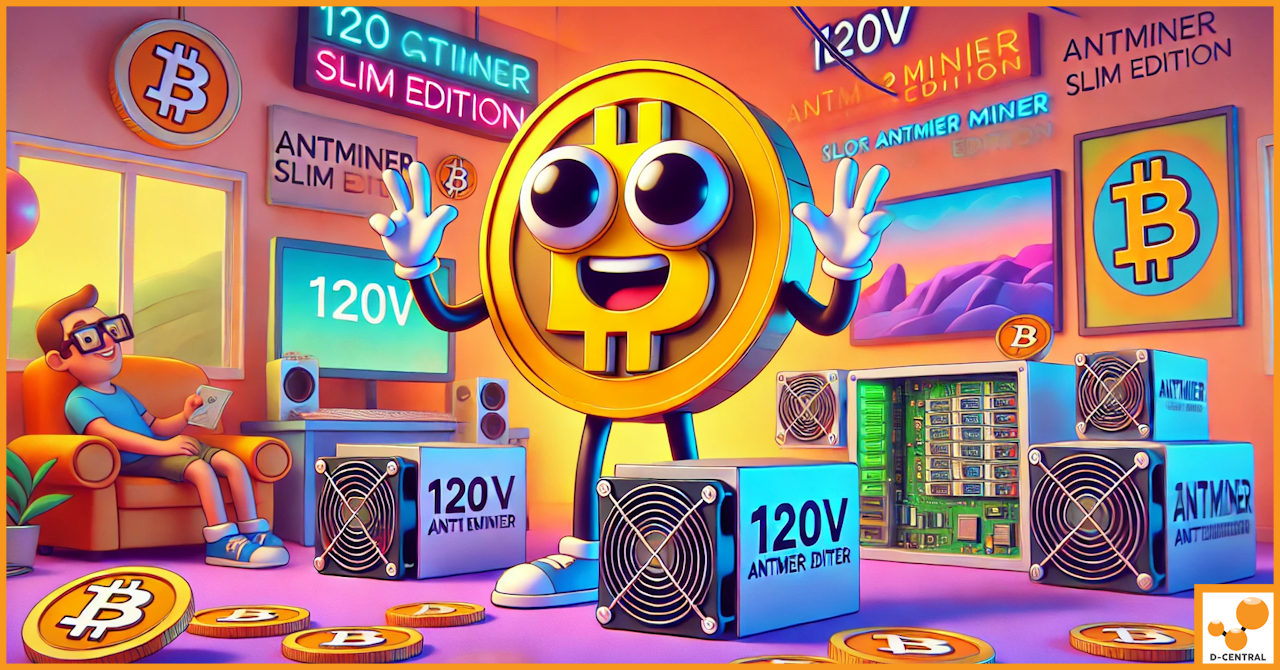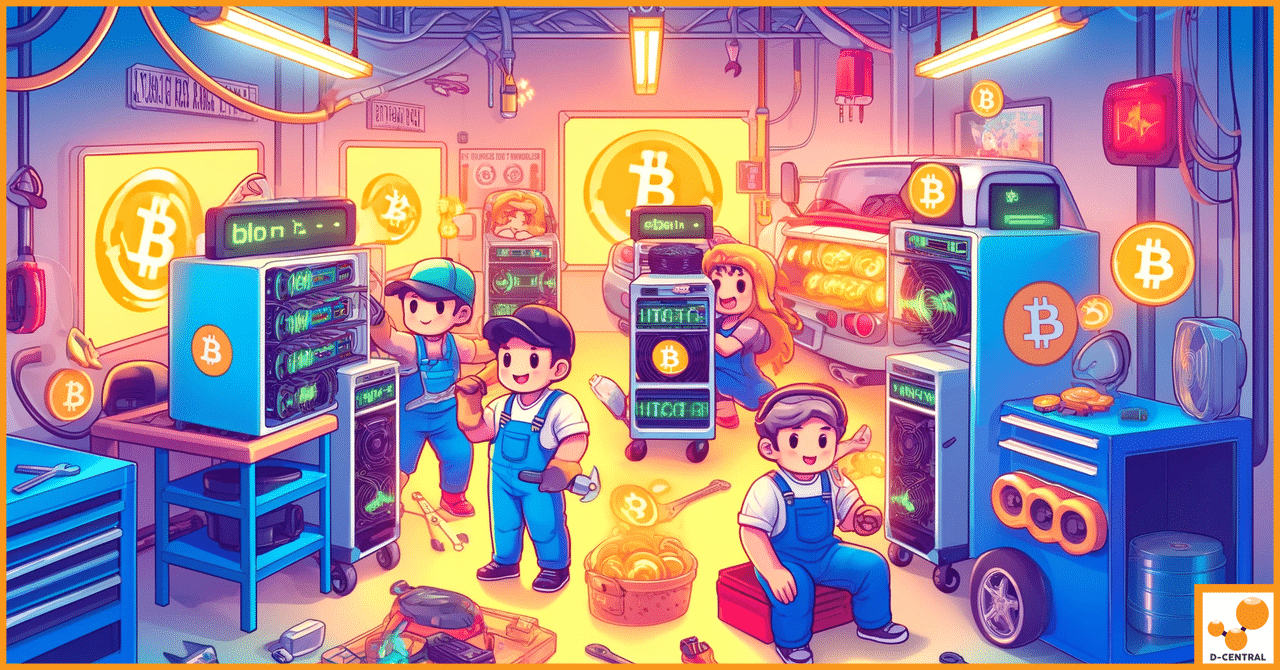
Unlock Home Mining with the 120V Antminer Slim Edition
Discover how the 120V Antminer Slim Edition is transforming the landscape of home cryptocurrency mining. Designed specifically for residential use,
4479 Desserte Nord Autoroute 440, Laval, QC H7P 6E2

In the exciting world of cryptocurrencies, Bitcoin stands as the pioneering and most prominent digital asset. At the heart of its operations is Bitcoin mining, a computational process that both creates new Bitcoins and verifies transactions on the Bitcoin network. While often viewed as an arcane and complex process, Bitcoin mining is an essential cog in the decentralized machine that is the Bitcoin network.
Central to the mining process is the concept of energy efficiency. The more efficient a mining operation, the more profitable it can potentially be. This is due to the simple fact that lower energy costs can translate to increased profitability. The advent of specialized hardware, such as Application-Specific Integrated Circuits (ASICs), has revolutionized the industry by significantly improving energy efficiency and, by extension, the potential profitability of mining operations.
Bitcoin mining has witnessed an extraordinary evolution since Bitcoin’s inception in 2009. Initially, Bitcoin mining was performed on personal computers, leveraging the CPU (Central Processing Unit) to execute the computations required to mine the cryptocurrency. These were the earliest days of Bitcoin mining, characterized by relatively low levels of competition and difficulty.
However, as more individuals and then enterprises started mining, competition increased, causing a spike in Bitcoin’s mining difficulty. Miners quickly discovered that CPUs weren’t efficient or powerful enough to keep up with the growing demands. The need for more computational power led to the use of GPUs (Graphics Processing Units), which offered a significant improvement in terms of power and efficiency over CPUs.
As Bitcoin’s popularity continued to rise, the quest for more efficient and powerful hardware led to the advent of FPGAs (Field Programmable Gate Arrays). FPGAs further improved efficiency but were eventually outpaced by ASICs (Application-Specific Integrated Circuits), which remain the gold standard for Bitcoin mining today.
ASICs are custom-built for Bitcoin mining, offering unparalleled efficiency and power. However, with the complexities and costs associated with developing new ASIC chips, and the diminishing returns of higher hash rates, the era of rapidly advancing ASIC models has slowed.
Let’s visualize this evolution in terms of energy efficiency (measured in Joules per Terahash or J/TH):
| Hardware Type | Hardware Name | Manufacturer | Release Date | Hashrate (GH/s) | Power (W) | Energy Efficiency (J/TH) |
|---|---|---|---|---|---|---|
| CPU | ARM Cortex A9 | ARM Holdings | January 2009 | Not Available | Not Available | 877,193 |
| GPU | ATI 5870M | ATI Technologies | September 2009 | Not Available | Not Available | 264,550 |
| FPGA | X6500 FPGA Miner | FPGA Mining LLC | August 2011 | Not Available | Not Available | 4,300 |
| ASIC | AvalonMiner Batch 1 | Canaan Creative | January 2013 | 66.3 | 620 | 9,351 |
| ASIC | KnCMiner Jupiter | KnCMiner | October 2013 | 400 | 600 | 1,500 |
| ASIC | Antminer U1 | Bitmain | December 2013 | 1.6 | 2 | 1,250 |
| ASIC | Bitfury BF864C55 | Bitfury | March 2014 | 40 | 20 | 500 |
| ASIC | RockerBox | HashFast | July 2014 | 400 | 1,260 | 315 |
| ASIC | ASICMiner BE300(S) | ASICMiner | September 2014 | 230 | 43 | 187 |
| ASIC | BM1385 | Bitmain | September 2015 | 3,500 | 590 | 168 |
| ASIC | Antminer S9-11.5 | Bitmain | June 2016 | 11,500 | 1,120 | 97 |
| ASIC | Antminer R4 | Bitmain | February 2017 | 8,000 | 845 | 105 |
| ASIC | Ebang Ebit E10 | Ebang | February 2018 | 18,000 | 1,650 | 91 |
| ASIC | Antminer S15 | Bitmain | April 2018 | 28,000 | 1,596 | 57 |
| ASIC | Antminer S17 | Bitmain | April 2019 | 53,000 | 2,100 | 40 |
| ASIC | Antminer S19 Pro | Bitmain | March 2020 | 110,000 | 3,250 | 29.5 |
| ASIC | Antminer S19 Pro XP | Bitmain | July 2022 | Not Available | Not Available | 21 |
From CPUs to the latest ASIC models, this table clearly shows the dramatic strides made in energy efficiency within the Bitcoin mining industry. This journey is ongoing as technology continues to evolve, opening new possibilities and challenges for Bitcoin miners worldwide.
In the journey of Bitcoin mining hardware evolution, ASIC (Application-Specific Integrated Circuit) models stand as the pinnacle of technological innovation and efficiency. Unlike CPUs, GPUs, or even FPGAs, which are general-purpose hardware capable of performing a variety of tasks, ASIC models are custom-built for a specific task – in this case, Bitcoin mining. This single-purpose design allows ASICs to be supremely efficient, providing a level of computational power and energy efficiency unmatched by any other form of Bitcoin mining hardware.
However, while ASICs offer distinct advantages, they also pose unique challenges. Firstly, the specialized nature of ASICs means that they become obsolete if the task they are designed for changes, as would be the case if the Bitcoin network changed its proof-of-work algorithm. This lack of flexibility contrasts with GPUs, for example, which can be used for various tasks beyond cryptocurrency mining.
Secondly, there is the trend of increasing complexity and cost in developing newer and more efficient ASIC models. The design and manufacturing of these specialized chips require significant investments in research and development, high-tech manufacturing facilities, and skilled labor. As we move along the technology curve, each increment in efficiency tends to come at a higher cost, leading to diminishing returns. This trend, coupled with increasing competition among ASIC manufacturers, has led to a slowdown in the production of more efficient ASIC models.
Interestingly, this slowdown has given a new lease of life to older ASIC models. These rigs, while not the most efficient, can still be profitable under the right conditions, such as low electricity costs and high Bitcoin prices. As a result, they maintain their competitiveness and resale value for a longer period. For many miners, these older ASIC models present a more affordable entry point into Bitcoin mining, balancing the trade-offs between initial investment, operational efficiency, and potential profitability.
In conclusion, while ASIC models represent the most advanced technology in Bitcoin mining, their inherent complexity, high development costs, and diminishing returns present unique challenges. However, these factors also create an environment where older ASIC models continue to hold their value and competitiveness, ensuring a diverse and inclusive mining landscape for both seasoned miners and newcomers alike.
As with many industries in the digital age, the Bitcoin mining community has found a home online, with platforms like Discord channels becoming hubs for information exchange, networking, and trade. These digital communities provide spaces for miners to share experiences, discuss strategies, troubleshoot issues, and keep up-to-date with the latest trends and technologies in the industry.
Among these communities, D-Central Technologies operates a dedicated Discord channel, serving as a dynamic and vibrant hub for Bitcoin miners of all levels. One unique feature of D-Central’s Discord channel is its marketplace section, offering a platform for the buying and selling of mining hardware.
The marketplace operates through listings, much like a classifieds section. Brokers and individual miners can post listings for mining rigs they wish to sell. However, D-Central goes a step further by offering a ‘certified listing’ service. In this process, the seller sends the units to D-Central prior to the listing. D-Central then inspects, cleans, and refurbishes the units to meet its stringent standards, ensuring that the rigs perform at a minimum of 95% of the expected hashrate. This certification process provides an additional layer of trust and security for buyers, who can purchase mining hardware with confidence in its quality and performance.
The marketplace caters to different types of orders: retail orders and lot orders. Retail orders are typically handled through D-Central’s online shop. These are suitable for miners who need a small quantity of rigs, perhaps for personal use or to supplement an existing operation. On the other hand, lot orders, which are larger bulk orders, are usually managed through Discord or Telegram. These are suited to larger mining operations or businesses seeking to enter the Bitcoin mining industry.
In essence, digital communities and marketplaces play a pivotal role in the Bitcoin mining industry. They provide an avenue for miners to interact, learn, and trade, thus fostering a sense of community and facilitating the growth and development of the industry. D-Central’s Discord channel and marketplace stand as prime examples of these platforms, underlining the company’s commitment to empowering and supporting Bitcoin miners worldwide.
The shifting landscape of Bitcoin mining, especially with the extended life expectancy of ASIC models, brings new opportunities for miners to capitalize on. As the pace of ASIC model development slows, miners now have the opportunity to fully harness the potential of their current equipment for a more extended period or explore the secondary market for mining hardware.
One of the significant advantages of this trend is the potential for increased hardware resale value. Incumbent miners can capitalize on this by liquidating their rigs at competitive market rates once they decide to upgrade or exit the industry. This helps to offset the initial investment costs and enhances the overall return on investment (ROI) for miners.
Moreover, the D-Central marketplace offers a unique proposition for those looking to enter the Bitcoin mining industry or expand their existing operations. With D-Central’s certified listings, miners can now buy refurbished ASIC models that have been thoroughly inspected and meet high-performance standards. This transparency regarding the performance history of the rigs provides miners with a higher level of confidence in their investment.
One of the significant advantages of purchasing refurbished and certified rigs from D-Central is the speed at which miners can start mining. Since the units are already cleaned, refurbished, and primed for operation, miners can start hashing the same day they make their purchase, offering a turn-key solution for eager participants.
These shifts in the Bitcoin mining landscape underscore the evolving opportunities for miners. Whether it’s through maximizing the lifespan of their current ASIC models, engaging in the resale market, or purchasing certified, refurbished rigs with a transparent performance history, miners now have multiple avenues to optimize their operations and potentially increase their profitability.
In the ever-evolving landscape of Bitcoin mining, understanding the nuances of hardware development, capitalizing on the extended life spans of ASIC models, and navigating the vibrant digital communities can spell the difference between successful mining operations and subpar efforts.
We’ve taken a journey through the history of Bitcoin mining hardware, tracing its evolution from CPU to the latest ASIC models. We’ve seen the increasing complexity and cost of ASIC models and how these trends have extended the competitive lifespan of older models. Alongside this, we’ve recognized the importance of digital communities and certified marketplaces like the one D-Central provides, facilitating an efficient and reliable trade of mining hardware.
The future of Bitcoin mining undoubtedly holds many exciting developments. As ASIC models continue to improve and communities like D-Central’s Discord channel flourish, the opportunities for both new and incumbent miners will continue to grow. Whether you’re a DIY enthusiast eager to build and maintain your own rig, or you prefer to let professionals handle the heavy lifting, D-Central has a solution tailored to meet your needs.
At D-Central, we’re not just offering services—we’re empowering individuals and communities to participate in the exciting world of Bitcoin mining. We invite you to leverage our wealth of knowledge, comprehensive services, and vibrant community to help you navigate your Bitcoin mining journey.
Question: What is the history of Bitcoin mining hardware?
Answer: Bitcoin mining hardware has evolved from the CPU used in the early days to GPUs, FPGAs, and ultimately to ASICs. Each evolution has seen a substantial increase in energy efficiency.
Question: What are ASIC models in Bitcoin mining?
Answer: ASIC models are specialized hardware devices designed to mine Bitcoin using a specific algorithm. They are more efficient and powerful than regular computers or graphic cards.
Question: What is the role of digital communities and marketplaces in Bitcoin mining?
Answer: Digital communities like Discord channels have become significant in the Bitcoin mining industry, providing platforms for miners to share experiences, discuss strategies, and trade mining hardware.
Question: What opportunities exist for Bitcoin miners?
Answer: Miners can capitalize on the extended lifespans of ASIC models, engaging in the resale market, or purchasing certified, refurbished rigs with a transparent performance history.
Question: How does D-Central Technologies Inc. support Bitcoin miners?
Answer: D-Central offers a range of services, including consulting, hardware sourcing, mining hosting, ASIC repairs, maintenance training, and mining support.
DISCLAIMER: D-Central Technologies and its associated content, including this blog, do not serve as financial advisors or official investment advisors. The insights and opinions shared here or by any guests featured in our content are provided purely for informational and educational purposes. Such communications should not be interpreted as financial, investment, legal, tax, or any form of specific advice. We are committed to advancing the knowledge and understanding of Bitcoin and its potential impact on society. However, we urge our community to proceed with caution and informed judgment in all related endeavors.
Related Posts

Discover how the 120V Antminer Slim Edition is transforming the landscape of home cryptocurrency mining. Designed specifically for residential use,
In the dynamic world of cryptocurrency, Bitcoin mining stands as a cornerstone activity, pivotal to the maintenance and expansion of

In an era where the realms of technology and sustainability intersect more than ever, the innovative fusion of cryptocurrency mining